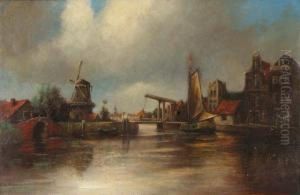Roelofs Paintings
Willem Roelofs was a Dutch painter, watercolorist, etcher, lithographer, and draughtsman. Born on March 10, 1822, in Amsterdam, he was one of the forerunners of the Dutch landscape painting movement known as the Hague School. His work is characterized by a careful and sensitive representation of the Dutch countryside, with a particular focus on the portrayal of water and light, which showcases his profound understanding and appreciation of nature.
From an early age, Roelofs showed an aptitude for art, and he was initially taught by landscape painter Hendrik van de Sande Bakhuyzen. In 1847, he moved to Brussels, where he became a part of the Belgian artistic circle and was influenced by the Barbizon School. His time in Belgium was significant, as he was exposed to new artistic trends that emphasized plein-air painting, which became a hallmark of his style.
Roelofs played a crucial role in the development of landscape painting in the Netherlands, and he was a mentor to many young artists, including Vincent van Gogh. He advocated for direct observation of nature and encouraged his students to paint outdoors. His landscapes often feature spacious views, tranquil waters, and a wide horizon, with a soft, harmonious color palette.
Throughout his career, Roelofs exhibited his work in various cities in Europe. His paintings were shown at the Salon in Paris and the exhibitions of living masters in the Netherlands. His contributions to Dutch art were recognized with several awards, and his works are collected by major Dutch museums, including the Rijksmuseum in Amsterdam.
Willem Roelofs passed away on May 12, 1897, in Berchem, Belgium. His legacy continues through his influence on the Hague School and the generations of landscape painters that followed. His commitment to portraying the serene beauty of the Dutch countryside has left a lasting impression on the world of art.
